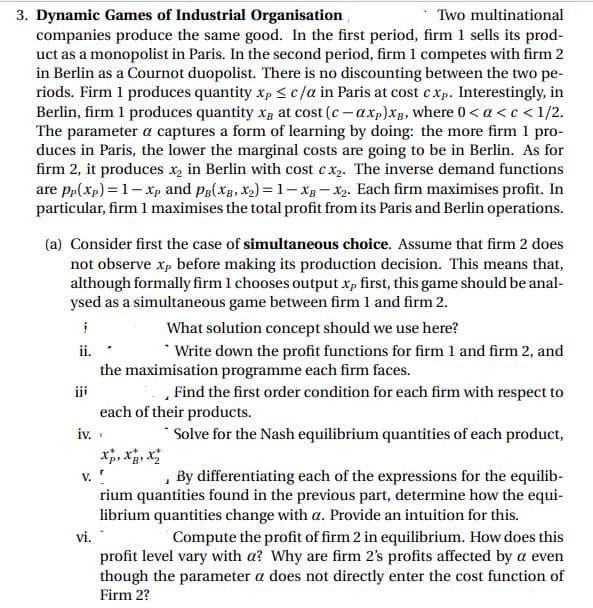3. Dynamic Games of Industrial Organisation companies produce the same good. In the first period, firm 1 sells its prod- uct as a monopolist in Paris. In the second period, firm 1 competes with firm 2 in Berlin as a Cournot duopolist. There is no discounting between the two pe- riods. Firm 1 produces quantity xp
3. Dynamic Games of Industrial Organisation companies produce the same good. In the first period, firm 1 sells its prod- uct as a monopolist in Paris. In the second period, firm 1 competes with firm 2 in Berlin as a Cournot duopolist. There is no discounting between the two pe- riods. Firm 1 produces quantity xp
Managerial Economics: Applications, Strategies and Tactics (MindTap Course List)
14th Edition
ISBN:9781305506381
Author:James R. McGuigan, R. Charles Moyer, Frederick H.deB. Harris
Publisher:James R. McGuigan, R. Charles Moyer, Frederick H.deB. Harris
Chapter16: Government Regulation
Section: Chapter Questions
Problem 2E
Related questions
Question

Transcribed Image Text:Two multinational
3. Dynamic Games of Industrial Organisation
companies produce the same good. In the first period, firm 1 sells its prod-
uct as a monopolist in Paris. In the second period, firm1 competes with firm 2
in Berlin as a Cournot duopolist. There is no discounting between the two pe-
riods. Firm 1 produces quantity xp <c/a in Paris at cost cXp. Interestingly, in
Berlin, firm 1 produces quantity xg at cost (c - axp)xB, where 0< a <c < 1/2.
The parameter a captures a form of learning by doing: the more firm 1 pro-
duces in Paris, the lower the marginal costs are going to be in Berlin. As for
firm 2, it produces x, in Berlin with cost cx. The inverse demand functions
are pp(xp) = 1- Xp and pa(xg, X2) = 1- xg-X2. Each firm maximises profit. In
particular, firm 1 maximises the total profit from its Paris and Berlin operations.
(a) Consider first the case of simultaneous choice. Assume that firm 2 does
not observe xp before making its production decision. This means that,
although formally firm 1 chooses output xp first, this game should be anal-
ysed as a simultaneous game between firm 1 and firm 2.
What solution concept should we use here?
ii.
* Write down the profit functions for firm 1 and firm 2, and
the maximisation programme each firm faces.
iji
, Find the first order condition for each firm with respect to
each of their products.
* Solve for the Nash equilibrium quantities of each product,
iv. .
xp, X, x
V.
rium quantities found in the previous part, determine how the equi-
librium quantities change with a. Provide an intuition for this.
By differentiating each of the expressions for the equilib-
vi.
Compute the profit of firm 2 in equilibrium. How does this
profit level vary with a? Why are firm 2's profits affected by a even
though the parameter a does not directly enter the cost function of
Firm 2?
Expert Solution
This question has been solved!
Explore an expertly crafted, step-by-step solution for a thorough understanding of key concepts.
Step by step
Solved in 2 steps

Knowledge Booster
Learn more about
Need a deep-dive on the concept behind this application? Look no further. Learn more about this topic, economics and related others by exploring similar questions and additional content below.Recommended textbooks for you

Managerial Economics: Applications, Strategies an…
Economics
ISBN:
9781305506381
Author:
James R. McGuigan, R. Charles Moyer, Frederick H.deB. Harris
Publisher:
Cengage Learning

Exploring Economics
Economics
ISBN:
9781544336329
Author:
Robert L. Sexton
Publisher:
SAGE Publications, Inc


Managerial Economics: Applications, Strategies an…
Economics
ISBN:
9781305506381
Author:
James R. McGuigan, R. Charles Moyer, Frederick H.deB. Harris
Publisher:
Cengage Learning

Exploring Economics
Economics
ISBN:
9781544336329
Author:
Robert L. Sexton
Publisher:
SAGE Publications, Inc


Principles of Microeconomics
Economics
ISBN:
9781305156050
Author:
N. Gregory Mankiw
Publisher:
Cengage Learning

Managerial Economics: A Problem Solving Approach
Economics
ISBN:
9781337106665
Author:
Luke M. Froeb, Brian T. McCann, Michael R. Ward, Mike Shor
Publisher:
Cengage Learning
